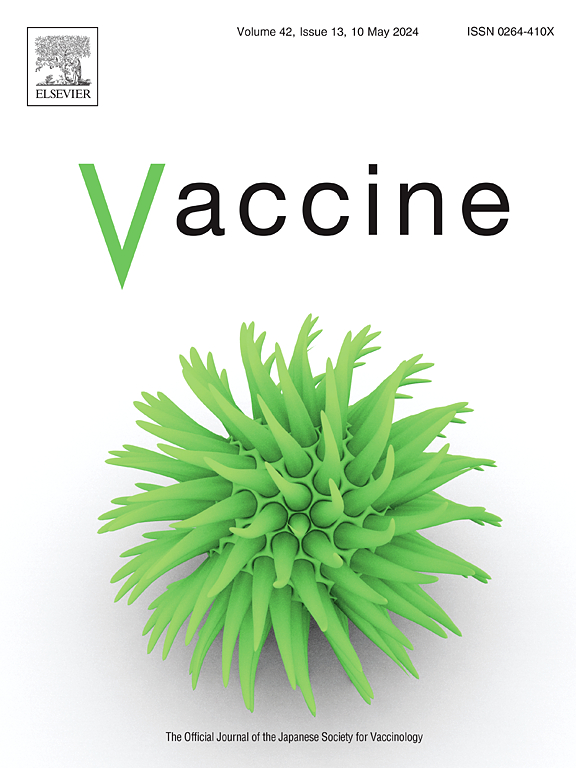巴西C型脑膜炎球菌结合疫苗在II期临床试验中的免疫原性、安全性和免疫记忆
IF 4.5
3区 医学
Q2 IMMUNOLOGY
引用次数: 0
摘要
脑膜炎球菌病(MD)是一种公共卫生负担。在包括巴西在内的许多国家,血清C型(MenC)是MD的主要病因,这强调了持续改进MenC结合疫苗的重要性。方法:II期随机单盲研究,纳入360例1 - 9岁未接种脑膜炎球菌疫苗的健康儿童,其中240例接种候选MenCC-Bio疫苗,120例接种参比疫苗neisvacc®。该疫苗由Bio-Manguinhos∕Fiocruz公司研制,每剂含:脑膜炎球菌C多糖10 μg(菌株2135),结合破伤风类毒素(10 - 30 μg)和氢氧化铝(0.35 mg Al+3)。评估血清转化(即转化为≥1:8或血清杀菌活性滴度增加4倍)和几何平均滴度(GMT)。接种疫苗后30天记录不良事件。初次接种后12个月评估血清保护的持续时间,并对最初进行血清转化的儿童进行加强剂量。结果:血清转化率为226/240 (94.2%);95% ci: 91.0%;MenCC-Bio为96.4%,118/120为98.3%;95% ci: 94.1%;99.8%)用于neisvacc®。MenCC-Bio被认为是非劣劣的(血清转化差异为- 4.1%;95% ci:−8.5%;0.3%)。然而,疫苗接种后杀菌GMT较差(MenCC-Bio = 230;参考疫苗= 1036),试验/参考GMT接种后比值为0.22(非劣效性截止值≥0.6)。5岁儿童的免疫原性差异更大。在12个月后重新评估的儿童亚群中,MenCC-Bio的血清逆转率为80.1%,参考疫苗为46.0%。再次接种后的GMT高于初次接种后,血清阴性志愿者全部变为血清阳性,表明免疫记忆较强。两种疫苗耐受性良好,不良事件为轻度或中度。结论:与neisvacc®相比,MenCC-Bio疫苗同样安全,但免疫原性较低。然而,高血清转化率和免疫记忆的诱导表明它在免疫计划中的有用性。本文章由计算机程序翻译,如有差异,请以英文原文为准。
Immunogenicity, safety and immunological memory of a Brazilian meningococcal C conjugate vaccine on a phase II clinical trial
Introduction: Meningococcal disease (MD) is a public health burden. In many countries, including Brazil, serogroup C (MenC) is the main cause of MD, emphasizing the importance of continuous improvement of MenC conjugate vaccines. Methods: Phase II randomized, single-blinded study, with 360 healthy and meningococcal vaccine-naive children from 1 to 9 years of age: 240 received the candidate MenCC-Bio vaccine and 120 received the reference vaccine Neisvac-C®. The test vaccine was developed by Bio-Manguinhos∕Fiocruz and contained per dose: meningococcal C polysaccharide 10 μg (strain 2135) conjugated to tetanus toxoid (10–30 μg), and aluminum hydroxide (0.35 mg Al+3). Seroconversion (i.e., conversion to ≥1:8 or a 4-fold increase in serum bactericidal activity titers) and geometric mean titers (GMT) were evaluated. Adverse events were recorded for 30 days following vaccination. Duration of seroprotection was assessed 12 months after primary vaccination, and a booster dose was administered in children who had seroconverted initially. Results: Seroconversion rates were 226/240 (94.2 %; 95 % CI: 91.0 %; 96.4 %) for MenCC-Bio and 118/120 (98.3 %; 95 % CI: 94.1 %; 99.8 %) for Neisvac-C®. MenCC-Bio was considered non-inferior (difference in seroconversion −4.1 %; 95 % CI: −8.5 %; 0.3 %). However, post-vaccination bactericidal GMT was inferior (MenCC-Bio = 230; Reference vaccine = 1036), and test/reference GMT post-vaccination ratio was 0.22 (non-inferiority cutoff ≥0.6). Differences in immunogenicity were higher for children <5 years old. In the subset of children reassessed after 12 months, seroreversion for MenCC-Bio was 80.1 % and 46.0 % for the reference vaccine. Post-revaccination GMT was higher than after primary vaccination, and all seronegative volunteers became seropositive, indicating strong immunological memory. Both vaccines were well tolerated, and adverse events were mild or moderate. Conclusion: MenCC-Bio vaccine was equally safe but had lower immunogenicity compared to Neisvac-C®. Nevertheless, the high seroconversion rate and induction of immunological memory indicates its usefulness in Immunization Programs.
求助全文
通过发布文献求助,成功后即可免费获取论文全文。
去求助
来源期刊

Vaccine
医学-免疫学
CiteScore
8.70
自引率
5.50%
发文量
992
审稿时长
131 days
期刊介绍:
Vaccine is unique in publishing the highest quality science across all disciplines relevant to the field of vaccinology - all original article submissions across basic and clinical research, vaccine manufacturing, history, public policy, behavioral science and ethics, social sciences, safety, and many other related areas are welcomed. The submission categories as given in the Guide for Authors indicate where we receive the most papers. Papers outside these major areas are also welcome and authors are encouraged to contact us with specific questions.
 求助内容:
求助内容: 应助结果提醒方式:
应助结果提醒方式:


